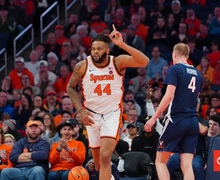Olmos Famous: Well-known activist speaks on diversity
Javier Vergara attended Edward James Olmos’s first speech at Syracuse University with his mother, Martha, in 1991. Javier, then 8 years old, asked the first question of the acclaimed actor, director and Latino activist: How did you get to where you are today?
This question carried special weight – both the young Vergara and the then-44-year-old Olmos have learning disabilities.
‘Mi hijito,’ he responded, ‘to get where I am takes discipline.’
Vergara recalled this inspiration in 2001, his mother said, when he introduced Olmos for his second SU appearance. Last night, Olmos returned to discuss his book, ‘Americanos: Latino Life in the United States,’ and American concepts of race while inspiring another generation.
‘He is the most prominent and renowned person in the Latino community to speak on these issues,’ said Matthew Camacho-Edwards, a diversity education specialist in the Office of Multicultural Affairs. ‘He has the vehicle to do it because of his celebrity.’
Olmos first addressed the Goldstein Auditorium audience in Spanish.
‘Anyone who can understand what I am saying right now,’ he said, ‘raise your hand with much pride.’
As the Spanish-speaking crowd erupted with laughter and cheers, he proved his point without translating his greeting.
‘For those of you that are Spanish-impaired, it’s OK. We live in an English-only country – don’t worry!’
The discussion, however, soon turned serious. At funerals, Olmos explained, his family wept for its lost loved one and then celebrated his or her life with food, drink and festivities. His speech was crafted in much the same way, interweaving grave cultural issues with lighthearted humor, laughter and fun.
He condemned the concept of race, instead defining individual cultures as integral parts of the one and only race – human. He mocked concerned lawmakers that struggle to deal with the Latino ‘explosion’ and praised the United States for the prosperity that draws so many immigrants to its shores.
Olmos confronted the audience with questions that exposed the harsh reality of cultural relations in the United States. He challenged the crowd to name an American hero of Asian or Latino descent. They tossed out a few names, but they agreed that none were true heroes. If not for Martin Luther King Jr., Olmos declared, there would not be one celebrated American of color.
Olmos concluded his hour-long speech to a standing ovation, and a brief question-and-answer period demonstrated that he had struck a chord with his attentive audience. One student identified with Olmos’s 1992 film, ‘American Me.’ The film chronicles the cycle between life in crime-riddled city streets and life in prison. The student, whose brother has been in and out of prison for 25 years, said it motivated him to succeed.
Another student, who moved to the United States from Chile after high school, echoed one of Olmos’s primary cultural concerns.
‘Sometimes we feel very discouraged,’ she said, ‘with being ‘not an American.”
Olmos’s visit to SU culminated in a book signing in the Schine Underground, where dozens of readers eagerly waited for a moment with the book’s architect and praised the evening’s presentation.
‘It was a great opportunity for the campus to get a real sense of what diversity is,’ said Eddie Campos, a second-year law student and public administrations master’s student, ‘and really understand that we’re not just different races, but we’re all really one combined culture.’
Olmos’s book provides a photographic journey through that culture and includes a foreword by esteemed Mexican author Carlos Fuentes. Co-editor Lea Ybarra suggested in her introductory speech that the book’s title, ‘Americanos,’ could replace controversial appellations like Hispanic and Latino. The new word, she argued, better symbolizes the values of biculturalism and bilingualism that pervade the culture.
As Olmos leafed through the book’s colorful pages on stage, he showed the diversity of Latinos living in the United States. He flipped between a photo of a family with two blonde-haired children and one of an black man waving the Panamanian flag. Latinos, he said, transcend skin color.
‘Why?’ he asked. ‘Because Latinos make love with everybody.’
Published on September 25, 2003 at 12:00 pm





